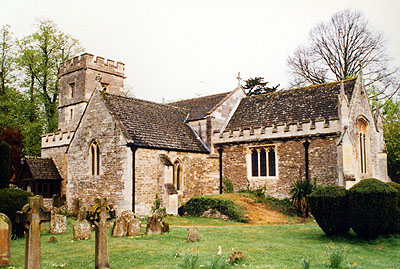 |
 |
|||
|
|
Radley has a rather typical looking North Berkshire church, of warm coloured stone with a small tower. Its initialed consecration crosses show when it was built, for they were apparently blessed by Nicholas Longspee, the Bishop of Salisbury from 1292 to 1297 and a grandson of Henry II. The old building is said to have been largely burnt down. The present church is medieval Perpendicular in style, with a large south chapel, and an unusual single-aisled nave, internally featuring wooden pillars supporting the roof. It is said that a medieval Abbot of Abingdon, who owned the manor as well as the church, was told in a dream to "seek [its] pillars in the forest". The building was reduced in size after Royalist soldiers barracaded themselves inside during the Civil War. They were under attack by a troop of Roundheads whose cannon subsequently knocked down the north aisle. They left some serious marks on the main door as well. Radley is a welcoming church with much of interest to see. Some features, like the Norman font (dug up in a farmyard) and possibly the altar, are original, while others were introduced by Sir George Bowyer of Radley Hall in the 1840s. The church is most proud of its stained glass found throughout the building. It largely features English Royal heraldry, but there is also a portrait of King Henry VII and, over the altar, three naked ladies bathing in a lake. It appears to be 16th century in date, some of it copied from the medieval glass at Ockwells Manor in Bray. But where did Bowyer get it from? The choir stalls with very late cherub-faced misericords came from Cologne. The superbly carved late medieval canopy over the pulpit is said to have come from William Lenthall's Speaker's Chair in the House of Commons. It was the seat from which he had been famously dragged, so perhaps, wishing to forget the incident, he ordered a replacement. He lived at nearby Besselsleigh and gave the canopy to Radley Church in 1653. The walls are covered with monuments and hatchments to the Bowyers, including that to the famous admiral, Sir George's father, by Nollekens. Chief amongst the monuments is that to his predecessors at Radley Hall, Sir William Stonhouse and his eldest son, John, designed by Nicholas Stone around 1632. It features two colourful recumbent effigies of the deceased and his wife lying on gold embroidered red and green cushions. Their son kneels at their heads, with other children, including four swaddled babies, below. It is remarkable that it survived the Civil War, perhaps its rather dark position, to the right of the altar, helped. For centuries, Radley was only a chapel, dependent on St. Helen's Church in Abingdon. However, over the years, its status was forgotten and, by the 16th century, the locals thought they lived in a "parish of itself". The Stonehouses began appointing rectors instead of chaplains being sent from Abingdon. Controversy continued until official parish status was finally granted in 1854. The church has had a vicar ever since. This is not the official Radley Church website. Please do NOT mail me about use of the church. Visit the C of E's Church Near You website instead.
|
|||
| © Nash Ford Publishing 2001. All Rights Reserved. The location of this church is now administered by Oxfordshire County Council. | ||||



 Radley
Radley